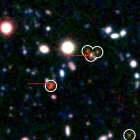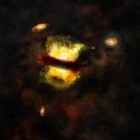The Intricate Role of Cold Gas and Dust in Galaxy Evolution at Early Cosmic Epochs
Dusty starburst galaxies at very high redshift represent an important phase in the early evolution of massive galaxies. They typically represent large-scale, gas-rich major mergers that trigger intense, short-lived bursts of star formation, which consume most of the available gas and drive the morphological transition to spheroids. At early cosmic epochs, these hyper-luminous galaxies commonly trace regions of high galaxy overdensity, and may be directly related to the formation of galaxy clusters and their giant central ellipticals. Molecular and atomic gas plays a central role in our understanding of the nature of these often heavily obscured distant systems. It represents the material that stars form out of, and its mass, distribution, excitation, and dynamics provide crucial insight into the physical processes that support the ongoing star formation and stellar mass buildup. I will discuss the most recent progress in studies of the cold gas content of dusty starburst galaxies at high redshift, back to the first billion years of cosmic time using CARMA, the Jansky Very Large Array, the Plateau de Bure interferometer, and the Atacama Large (sub)Millimeter Array (ALMA). I will also highlight our recent successful first detections of the interstellar medium in "normal" (~L*) galaxies at z>5 with ALMA, and discuss the impact of our findings on future studies back to even earlier epochs.


